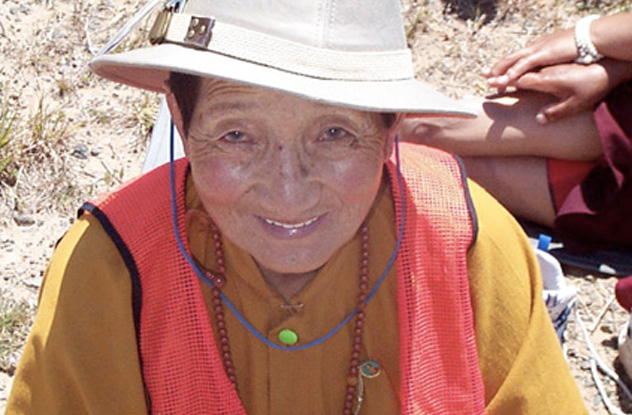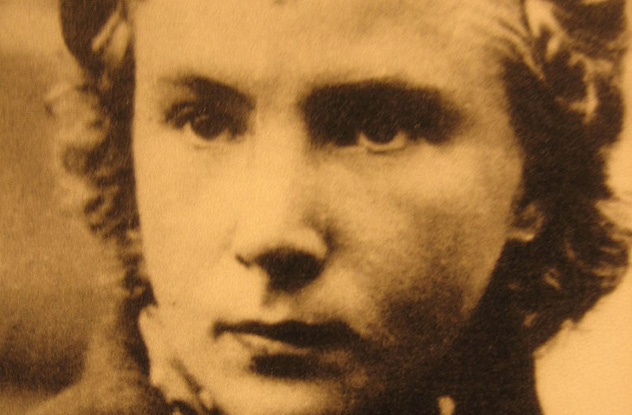 Music
Music  Music
Music  History
History 10 Less Than Jolly Events That Occurred on December 25
 Weird Stuff
Weird Stuff 10 Funny Ways That Researchers Overthink Christmas
 Politics
Politics 10 Political Scandals That Sent Crowds Into the Streets
 Weird Stuff
Weird Stuff Ten Bizarre Facts About The Doge Meme
 Our World
Our World 10 Ways Your Christmas Tree Is More Lit Than You Think
 Movies and TV
Movies and TV The 10 Coolest Stars to Set Sail on The Love Boat
 History
History 10 Things You Didn’t Know About the American National Anthem
 Technology
Technology Top 10 Everyday Tech Buzzwords That Hide a Darker Past
 Humans
Humans 10 Everyday Human Behaviors That Are Actually Survival Instincts
 Music
Music 10 Surprising Origin Stories of Your Favorite Holiday Songs
 History
History 10 Less Than Jolly Events That Occurred on December 25
 Weird Stuff
Weird Stuff 10 Funny Ways That Researchers Overthink Christmas
Who's Behind Listverse?

Jamie Frater
Head Editor
Jamie founded Listverse due to an insatiable desire to share fascinating, obscure, and bizarre facts. He has been a guest speaker on numerous national radio and television stations and is a five time published author.
More About Us Politics
Politics 10 Political Scandals That Sent Crowds Into the Streets
 Weird Stuff
Weird Stuff Ten Bizarre Facts About The Doge Meme
 Our World
Our World 10 Ways Your Christmas Tree Is More Lit Than You Think
 Movies and TV
Movies and TV The 10 Coolest Stars to Set Sail on The Love Boat
 History
History 10 Things You Didn’t Know About the American National Anthem
 Technology
Technology Top 10 Everyday Tech Buzzwords That Hide a Darker Past
 Humans
Humans 10 Everyday Human Behaviors That Are Actually Survival Instincts
10 Heroic Women Warriors Who Fought Against Tyranny
History and pop culture have given us hundreds, if not thousands, of stories involving damsels in distress. Only occasionally do we hear of figures such as Mulan and Boudicca who show the strength and prowess of women on the battlefield. Here are tales of 10 such warrior women who fought against oppression and attack.
10Gabriella Silang & Dayang-Dayang
Filipina Guerrillas

British ships bombarded Manila Bay on September 24, 1762 as part of the growing Anglo-Spanish War. Diego Silang, a native of Ilocos, thought it was the best time to foment a revolution against the Spaniards by allying with the British. The Brits proclaimed him governor of Ilocos and then promised him help that never arrived.
In May 1763, he was assassinated, leaving his widow Gabriella Silang in charge of the rebel force. She conducted numerous attacks against Spanish-held towns, vanishing deep into the forests and recruiting tribal warriors. Some of the indigenous tribes turned their backs, aiding the Spaniards in capturing her. She and her companions were executed on September 20, 1763. Gabriella Silang’s bravery against Spanish tyranny gained renown, putting women at the forefront of a brewing revolutionary spirit.
Nearly 300 years later, the Philippines faced another foreign enemy, this time the Japanese during World War II. The fledgling Hukbo ng Bayan Laban sa Hapon (“The Nation’s Army Against the Japanese”), or HUKBALAHAP, contained farmers and peasants from the provinces, many of whom were recruited by guerrilla Felipa Culala. Culala took the nickname “Dayang-Dayang,” after a Muslim princess who once fought the Spaniards.
Dayang-Dayang and her peasant army freed captives from a local jail on March 8, 1942. When the Japanese and Filipino collaborators attempted a pursuit, Culala laid an ambush, killing over 100 men and capturing armaments. Culala later earned the ire of her superiors in the HUKBALAHAP, who cited her insubordination, her haughty attitude, and reports of thievery among her troops. She was executed by her own comrades late in 1943.
9Empress Taytu
Ethiopian Warrior Queen

Ethiopian history records amazing tales of noblewomen who were instrumental in preserving their nation. Queen Yodit, mentioned in old texts, was said to have fought spiritedly in battles, successfully overthrowing the Kingdom of Axum. Later on in 1520, Queen Eleni, wife of King Zere Yaqob, formed a coalition with the visiting Portuguese against the Turks and Egyptians. Queen Seble Wogel called on European aid against Muslim invaders in 1543.
In the illustrious history of Ethiopian women, perhaps no one shined brighter than Empress Taytu, consort of Emperor Menelik II. When an Italian count threatened the Empress with war, she boldly replied, “Do not even waste your time here. Go on with your war. We will await you eagerly!” When her brother cowered at the thought of conflict, Taytu suggested he wear her skirt, while she would wear his trousers instead.
On March 1, 1896, during the pivotal Battle of Adwa, Empress Taytu was reported to have surrounded herself with riflemen, directing the artillery against advancing Italian forces. Her leadership and battle cries broke the Italian offensive. Afterward, the Empress called for 10,000–12,000 women to carry jugs of water from the river to the men on the front.
Her bravery inspired women all over the country. Peasant Tigray women destroyed telegraph wires with stones, while foreigners could hardly believe their own eyes when they saw women firing at them with rifles. The courage of the Empress led Ethiopia to the first overwhelming victory of an African nation against European powers during the colonial era.
8Queen Nzinga Mbande
Matriarch Against The Portuguese

It was early in the 17th century, when Portugal was occupying the Ndongo kingdom of Angola. The King of Ndongo sent his sister to arrange a treaty with the Portuguese. The Europeans, upon seeing an African woman as the envoy, thought the idea so ridiculous that they did not even offer her a seat. The envoy approached the table nevertheless, ordering one of her entourage to crouch so she could sit on her back. This envoy was Princess Nzinga Mbande.
When the king committed suicide in 1626 (or was poisoned by the princess, according to rumor), Nzinga Mbande inherited the throne of Ndongo. The young queen used diplomacy to stem the rising tide of Portuguese aggression, first by adopting Christianity, being baptized as Anna de Souza.
When the Portuguese proved to be relentless adversaries, she sought an alliance with the Dutch. As the tide of battle turned, Nzinga turned her attention toward the neighboring Kingdom of Matamba, which she swiftly conquered, giving her people a new home. Consolidating their efforts, the Queen and her allies conducted guerrilla operations against the Portuguese until her death on December 17, 1663, when she was well over 80 years old.
7Nakano Takek
The Onnabugeisha

Nakano Takeko was one of a select few women in Japanese history known as the onnabugeisha, literally “women skilled in martial arts.” They were not formally recognized as samurai, though their bravery in battle equaled or even exceeded that of their male counterparts. Tomoe Gozen, for example, slew many of her enemies and survived the Genpei War during the late 12th century.
Nakano took up arms during the Boshin War (1868–1869), a time when rule of the Shogunate was threatened by supporters of the Emperor. The Boshin War also signified the fall of the samurai, leading to the diminishment of their traditions and influence. Nakano was present during the Siege of Wakamatsu Castle in Aizu. Popular depictions of the battle show Nakano and several women (retroactively known as Joshutai, or “Women’s Army”) charging Imperial riflemen. Nakano took down five or six men with her naginata polearm before she was mortally wounded by gunfire.
To preserve her honor and prevent her enemies from capturing her as a trophy, she bade her sister, Masako, to cut off her head. It was later brought to a local temple for burial.
6Mother Lu
The Chinese Restorer

Han Dynasty official Wang Mang the Usurper brought great chaos to his once-peaceful land. He fabricated omens to signify that a new dynasty under his rule was to begin, and on January 10 in A.D. 9, he declared that the Han had fallen. He proclaimed himself Emperor of the short-lived Xin Dynasty. Riots and famine marked his rule, and people clamored for peace to be restored.
In A.D. 14, Wang Mang’s government executed an official named Lu Yu for a misdemeanor. His mother, soon to be known as “Mother Lu,” sought vengeance. She gained support from newfound friends and her business ventures as well as from her kind treatment of laborers.
With her forces numbering over 100 peasants, Mother Lu proclaimed herself general of a rebel army. New recruits called themselves the “Strong Tigers.” She led them to Haicheng in A.D. 17, where she put to death the official who ordered her son’s execution.
This tale made Mother Lu a symbol in the fight to end the usurper’s rule. When she died a year later, her followers spread word of her deeds throughout China. Those few hundred men went on to carry the banners of a large-scale revolution that toppled Wang Mang and restored the Han in A.D. 25.
5Ani Pachen
The Warrior Nun Of Tibet

Born Pachen Dolma, this young woman received the name Ani Pachen after becoming a Buddhist nun. The name roughly translates to “Nun Big Courage,” and never has a name been more apt.
From 1958 to 1960, Nun Big Courage led 600 resistance fighters against the forces of communist China. These common folk of the mountains and hills rode out on horseback against Chinese tanks. Her leadership against the odds earned her the nickname “The Tibetan Joan of Arc.”
Ani Pachen was captured in 1960. Where thousands of Tibetans were executed due to their superstitious beliefs, Pachen spent 21 years in prison, enduring humiliation and torture from her captors. She was later asked how she kept her strength through several days of being hung by her wrists, months in solitary confinement, or years in leg irons. The brave nun said that her wish to see the Dalai Lama kept her alive.
She was released in 1981. She then traveled the world, telling small gatherings of the tragic plight of her people. Once her book Sorrow Mountain was published, her story spread far and wide.
Ani Pachen lived in exile from 1988 until her death in 2002. The people of Tibet still struggle against Chinese subjugation.
4Christine Granville
From Poland With Love

She was born Maria Krystina Janina Skarbek to a wealthy family in Poland. Her life was said to have been quite uneventful, her only known achievement was being the runner-up in a beauty contest held in 1930. When the Second World War broke out years later, however, she was in South Africa with her husband, a diplomat. She immediately headed to London and demanded that she join the war effort as a spy.
She adopted the name “Christine Granville” and set out for war-torn Poland—by skiing over the Carpathian Mountains. Officially, she was to bring British propaganda to occupied cities; unofficially, she wanted to save her Jewish mother.
Granville ferried messages and people during the early years of the war with her companion (and alleged lover), a one-legged Pole named Andrzej Kowerski. A plane once strafed her, and she narrowly dodged death. Once, she was captured by the Gestapo; she immediately bit her tongue and told her captors that she had tuberculosis, scaring the men into releasing her.
In 1944, Granville saved her fellow agent (and new lover) Francis Cammaerts by claiming to be Field Marshal Montgomery’s niece, threatening their would-be executioners with harsh Allied punishment. This was one of several dalliances during the war. One spurned lover threatened to shoot himself in the genitals but ended up missing and shooting his foot instead. Granville’s whirlwind romances came to an abrupt halt, however, when a stalker named Dennis Muldowney fatally stabbed her on July 15, 1952.
3Lilya Litvyak
Hero of the Soviet Union

When Germany broke its non-aggression pact with the Soviet Union in 1941, many women volunteered to take the fight to the Nazis. One of them was Lilya Litvyak, who became an instructor and later on a full-fledged fighter pilot in combat zones.
Litvyak’s carefree spirit and positive attitude brightened other soldiers’ lives. She painted a white lily on the nose of her Yak-1. Enemies who saw her skill in the air mistook the flower for a rose, giving her the nickname “The White Rose of Stalingrad.”
On September 13, 1942, Litvyak became the first female pilot to shoot down an enemy plane, downing German pilot Erwin Maier over Stalingrad. Maier, who was captured on the ground, asked to be shown to the Russian ace. When the Soviets brought him before the diminutive Litvyak, he thought the Russians were pulling a prank. His laughter ended when Litvyak described their dogfight in vivid detail, shocking Maier so much that he offered her his gold watch. Litvyak declined, saying, “I do not accept gifts from my enemies.” She went on to rack up more victories, 12 on her own and four shared among other pilots.
Litvyak’s disappearance on August 1, 1943 became the subject of debate among historians. Her plane, sporting the white lily, was spotted by Germans who immediately ganged up on the pilot. Her plane was shot down, but the wreck and her remains were not found. Some claimed that she survived the crash, became a POW, and later escaped.
In 1969, a body believed to have been Litvyak was found in Belarus. Only in May 1990 did Mikhail Gorbachev posthumously award her the title Hero of the Soviet Union.
2Rani Lakshmi Bai & Begum Hazrat Mahal
Revolutionaries Against The British

In the Great Indian Mutiny of 1857, thousands of men fought to preserve their traditions from the violation of Europeans. A handful of women also participated. One was Rani Lakshmi Bai, wife of the Rajah of Jhansi.
When the Rajah died in 1853, the British sought to annex Jhansi, declaring that her adopted son was not a legal heir. In late 1857, Lakshmi Bai donned men’s clothing and led an army. She was determined to resist the British, declaring: “Main Jhansi nahi doongi!” (“I will not give Jhansi.“)
Her army and additional troops captured the city of Gwalior in 1858. On June 17 of that year, British forces recaptured Gwalior, and Lakshmi Bai fell in battle while rallying her beleaguered forces. One story says that the Rani, dressed in a cavalry officer’s uniform, was wounded by gunfire and later on was cut down. Long vilified by the British, who considered her a “Jezebel,” Lakshmi Bai would become one of the most enduring symbols of Indian resistance to British rule.
One of her contemporaries was Begum Hazrat Mahal, a concubine of the king of Oudh. The kingdom’s annexation by the British East India Company led Hazrat Mahal to denounce the foreigners inciting the populace. She led troops in battlefields as well, seated on a war elephant. Decades later, historians referred to her as the Lakshmi Bai of Oudh.
1Mai Bhago & Bibi Sahib Kaur
Sikh Warrior Women

In 1704, the fortress of Anandpur in Punjab was under siege from the Mughals and various hill tribes. Sikh followers of Guru Gobindh Singh, last of the living Sikh gurus, became wary of their position. The Mughals proclaimed that any man who renounced being a Sikh could pass freely. Forty signed the Bedava, a document saying they were no longer Sikhs nor followers of the Guru.
When Mai Bhago learned of this incident, she rode forth to challenge the deserters, shaming and chastising them for their cowardice. The 40 men admitted their fault, riding back with Mai Bhago to aid the Guru. In the Battle of Muktsar the following year, Mai Bhago led the 40 Sikhs in battle against 1,000 Mughal soldiers. Combat was fierce, but she prevailed, saving the Guru’s life.
Unfortunately, the Sikhs later all died, Guru Gobind Singh got hold of the Bedava, and he immediately tore the document and forgave the men’s transgressions. They became known as the Chali Mukte—the 40 who attained salvation. Mai Bhago remained with the Guru, his companion and bodyguard dressed in male attire, until he died in 1708.
A century later, another Sikh warrior woman left her mark on history. In 1794, Bibi Sahib Kaur led a local force to rescue her husband from captivity. Soon, a Maratha contingent besieged her town as well. Brandishing a sword, she rallied her forces in defense of their town. In 1799, British adventurer George Thomas raided neighboring Sikh towns. Sahib Kaur marched at the head of her army, repelling the Englishman.
+The Women Of The American Revolution And Civil War

Women were often confined to supporting roles during conflicts in America’s infancy, bringing water to the men or nursing them back to health. Mary Hays McCauly was doing just that during the Battle of Monmouth on June 28, 1778. Suddenly, her husband collapsed, and she took it upon herself to operate the cannon for the rest of the battle. Though her identity and even existence is very much disputed, the legend of “Molly Pitcher” became an enduring folktale.
Similarly, Margaret Corbin’s husband fell while defending Fort Washington on November 16, 1776. Corbin took his place among the gun crew, blasting British troops until her arm was nearly severed by grapeshot. Corbin was discharged after the war, becoming the first woman to receive a pension from Congress for her services during the Revolution.
During the Civil War, hundreds of women, whose names are now lost in history, volunteered as part of both Union and Confederate forces. Women passed the physical (which was not as thorough as one might think), bound their breasts, wore loose clothing, and rubbed dirt on their faces to look like scrappy boys.
Jo’s great-grandmother aided local guerrilla forces who fought the Japanese during the Second World War.You can talk to him via email or in the comments section.








